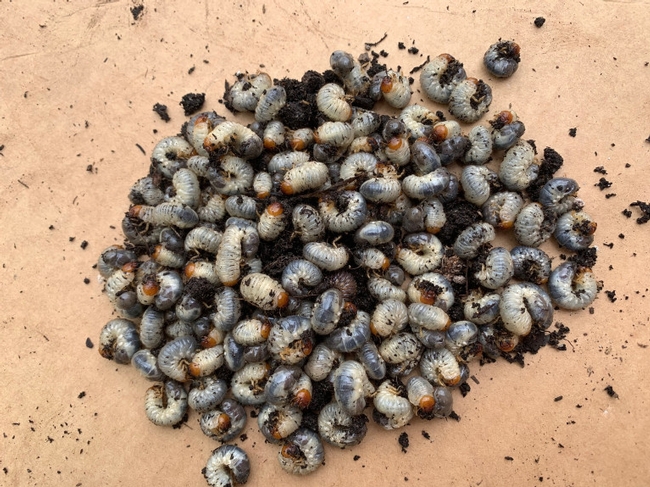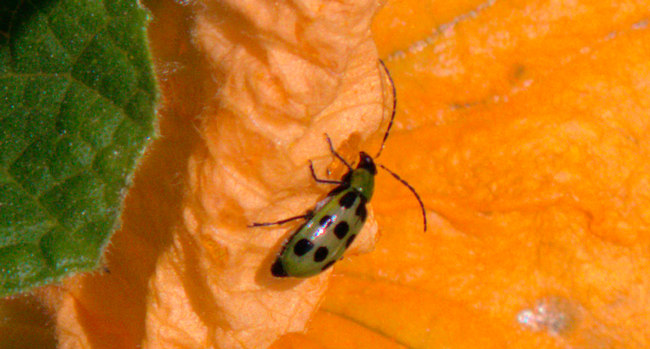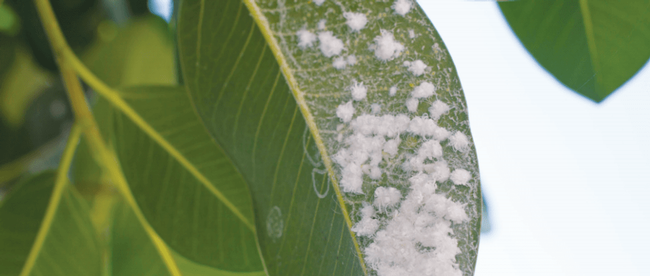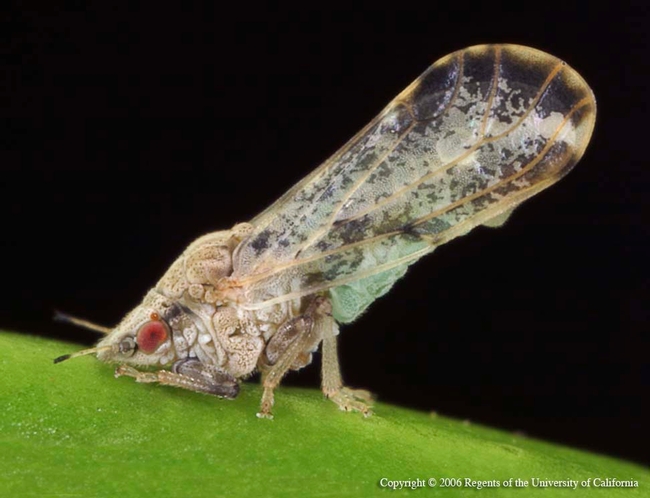
White grubs are the larvae of several species of scarab beetles. They are weird, kind of alien-looking little creatures that curl up into a C-shape when disturbed. They tend to grow to around 1-inch long, but some species can get much larger.
I have three raised beds in my garden area and replant them every spring and fall.
For the last couple of years, I have found an unusually large population of what I believe is a kind of grub called Cyclocphala, or masked chafers. The larvae have brown heads and legs and have dark stripes across their backs. The adults (beetles) are golden-brown and have an almost armor-like, shiny coating on them.
“It is not possible to identify these grubs without looking closely at features such as mouthparts and small hairs (called setae) located on their bodies,” said Karey Windbiel-Rojas, with the University of California Statewide Integrated Pest Management Program.
“However, they are the larvae of scarab beetles, and based on where you found them, they could be masked chafers, green fruit beetles, or something similar. What they are very likely NOT are Japanese beetle larvae, since those are more or less non-existent in California.”
Handpicking grubs from raised beds (as I do) and containers can be all the control needed. I have had no noticeable plant damage in my beds.
If you or a neighbor have chickens, they absolutely love grubs and will be overjoyed to help you cut down the population.
Grubs can, however, do major damage to turfgrass. Most damage occurs during late summer or early fall. You will see patches of brown, drying lawn in the infested areas.
Additional damage is often done by moles, voles, birds or skunks that are digging in the grass to feed on the grubs.
Before taking any control measures, dig around the root level of the grass to confirm that in fact the damage is caused by grubs. If you find more than six grubs per square foot, you may want to take action.
Since grubs feed close to the surface, aerating the soil can kill significant numbers of them.
Nematodes (tiny, microscopic roundworms) can also be applied to control grubs. They should be applied when the grubs are young and not overpopulated.
It is best to do so in late summer or early fall. A second application is highly recommended. Be sure to do your research about the proper way to prepare and apply nematodes for grub control.
If these natural measures don't work, it is important to know what kind of grub (or any other kind of pest) you have before deciding to use chemical control.
Get advice about the right chemical to use and the right amount necessary to get the job done. A wrong decision can mean wiping out other species.
You can take a grub (or another pest) specimen into your local Master Gardener office to get information about what to do.
by UC Master Gardener Rebecca Jepsen
This article first appeared in the May 19, 2019 issue of the San Jose Mercury News.

First, you need to make it difficult and less desirable for larger mammals such as rats and rabbits to get to the garden. To deter rabbits, make sure the area is fenced, with the bottom of the fence at least 6 inches below ground. To discourage rats, remove all garbage or store it in a closed, animal-proof can.
Pick up and discard all fallen fruit or nuts. Clear away all hiding/nesting places such as low-growing branches and stacks of firewood; trim shrubs and foliage to at least a foot off the ground. Remove all sources of standing water: buckets, flower pots, bins, lids, and old tires. Keep your barbeque clean, as rats are attracted to leftover food and grease. If you are composting, don't add eggs, greasy food or meat and make sure you have a metal mesh barrier beneath to prevent them from coming up through the bottom.
My garden is fenced; I am growing only in raised beds and I have removed all standing water. As an avid animal lover, I don't wish harm on any living thing, not even a spider (most of which are extremely beneficial). However, last year, we lost nearly half of our tomatoes, lots of leafy greens and all but two or three of our persimmons to rats and rabbits. This spring, all of my sugar snap peas and most of my chard and kale were eaten down to the stems. And when something starts messing with your tomatoes it's time to take action!
We hired a trapping service, and it has been very effective so far. We have caught several rats, a handful of rabbits and even a few gophers and voles. There are several licensed services in the Bay Area that can legally trap and remove the animals from your property. My one remaining chard plant has now made a full recovery, there are hundreds of tomatoes on the vine that are just weeks away from ripening, and the persimmon tree (so far) is loaded with fruit.
Much smaller pests you may be seeing now include an array of aphids, beetles, worms, stink bugs and grasshoppers.
Aphids are tiny pear-shaped bugs that suck the sap from plant leaves, causing them to curl and drop. They leave honeydew, which promotes viral disease and sooty mold. Blasting your plants with a strong stream of water will wash away most of the aphids. Planting plants such as white alyssum, yarrow, and fennel will attract ladybugs, lacewings and other beneficial insects that devour aphids.
There are lots of beetles to look out for. Both the spotted and striped cucumber beetle have been prevalent this year. They do most of their damage before you even know they are there. Larvae attack the roots just as the plants are getting started. Adults will continue to wreak havoc, so hand-picking or vacuuming them off is important. They will attack not only cucumbers, but pumpkins, melons and all squash as well. Using row cover for seedings will help, but you need to remove it as soon as the flowers appear to allow the pollinators to do their job.
Caterpillars and worms can do lots of damage very quickly. You need to inspect the underside and inside of curled leaves thoroughly, as many blend in quite well with green leaves. Although it may be “yucky”, the best nontoxic pest control is to handpick and squish them.
Grasshoppers are one of the most difficult pests to control. If you see only a few, you can again handpick and discard them. Row covers can help. But if the population is high they can chew right through the cloth. Some gardeners have been successful in planting a row of tall grasses and other lush plants around the garden to divert their attention.
When all else fails, and you need to resort to a chemical solution, please bear in mind that the good bugs will be killed off alongside the bad ones. So use this as a last resort!
by UC Master Gardener Rebecca Jepsen
Photo from the San Jose Mercury News
This article first appeared in the July 22, 2018 print issue of the San Jose Mercury News.
If you have citrus trees, you likely have citrus mealybugs

Citrus mealybug description
All mealybugs are soft, flat, oval-shaped critters with segmented bodies. The mealybugs that attack Morgan Hill citrus are covered with a white wax that also creates spines (filaments) around the outer edge and the back end of the bug. Unless you use a hand lens you probably won't notice individuals, but mealybugs colonize areas creating white, fuzzy egg clusters that are easy to spot.
Mealybug lifecycle
When mealybug eggs hatch the crawlers are pale yellow with red eyes, and distinct antennae. Crawlers are not born with their protective wax coating. They begin to excrete it soon after hatching. They are called crawlers because they crawl to a feeding site, where they will continue to develop (and damage fruit) for a month or two.
Citrus mealybug damage
Each female mealybug can lay hundreds of eggs, and there are usually two or three generations a year, so infestations can become a problem. As sapsuckers, citrus mealybugs pierce fruit, leaves, and young stems to get at the sap. They also feed on tender, new growth. As they feed mealybugs leave behind a trail of honeydew that attracts ants and creates the perfect growth medium for sooty mold. Citrus mealybug feeding near fruit stems also leads to fruit drop. This feeding also reduces fruit quality. Trees fail to thrive and are prone to infestation by disease and other pests. In addition to oranges, lemons, limes, and grapefruit, citrus mealybugs also have a taste for ornamental plants, such as tulips, coleus, cyclamen, begonias, and dahlias.
How to control citrus mealybugs
The first step to controlling citrus mealybugs is to monitor your trees, especially in spring and fall, for signs of ant trails, sooty mold, and egg clusters. Since ants will protect and farm the aphids for their honeydew, apply sticky barriers to tree trunks to block ants from protecting the aphids against natural predators. Those natural predators are your trees' best defense against citrus mealybugs. Lady beetles, lacewings and hoverflies will devour these pests so avoid using broad-spectrum pesticides. For extreme infestations, you can buy an introduced predator called the mealybug destroyer (Cryptolaemus montrouzieri). Insecticides are not recommended. Diatomaceous earth and insecticidal soaps can also be used.
Mealybugs prefer dusty conditions so hosing trees off can make them less appealing to citrus mealybugs.
by UC Master Gardener Kate Russell
This article first appeared in the March 23, 2018 issue of the South Valley Magazine.
Cabbage aphids wreak havoc in the garden

Cabbage aphids (Brevicoryne brassicae) can wipe out a cabbage crop before it ever gets started. Native to Europe, this pest of cole crops is now found throughout the United States.
Like other aphids, cabbage aphids are small, teardrop-shaped, sap-sucking pests that can reproduce at an alarming rate. While soft-bodied cabbage aphids are actually grayish-green, they look powdery blue to grayish-white because of a waxy covering. Cabbage aphids are not difficult to see because they live in dense colonies that can cover stems, new leaves, and entire plants practically overnight. In our moderate climate, these pests produce live offspring year-round.
Aphid defense
Cabbage aphids have an amazing defense mechanism. They produce an enzyme in their head and throat muscles which gets combined with defensive chemicals (glucosinolates) from their host plants to create an explosive chemical reaction. This reaction produces mustard oil. Unfortunately, this “walking mustard oil bomb” defense is particularly effective against ladybug larva.
Vulnerable plants
Cabbage aphids feed on the youngest, most tender parts of new cabbage, broccoli, Brussels sprouts, kale, and cauliflower. These pests also eat the innermost parts of cabbage and Brussels sprouts heads. Large colonies can stunt or even kill young plants. Heavy aphid feeding causes leaves to curl up, providing the pests with a protective cover.
Aphid controls
Prevention is key to cabbage aphid control. Row covers are an excellent way to protect young crops while they are getting established. Once aphids are seen you can often use a strong spray from the garden hose to dislodge them. If that doesn't work, insecticidal soaps can provide some control. Since some insecticidal soaps may be phytotoxic (meaning sunlight causes them to burn the plant), it is a good idea to apply them on a foggy day, especially for cabbage and Brussels sprouts.
Another way to make life more difficult for cabbage aphids is to remove any weeds in the mustard family from your property. Cabbage aphids hide out in the mustard and then return to your garden plants. Pesticides can be used as a last-ditch effort, but aphids are developing resistance to these chemicals—a potentially dangerous spiral.
Another problem with using pesticides against cabbage aphids is that those same chemicals also kill beneficial, predatory insects, such as lady beetles, parasitic wasps and syrphid flies (hoverflies). These helpful insects are natural predators of caterpillars, imported cabbage worms, diamondback moths, loopers and armyworms, which can cause other problems for your cole crops.
Monitor your plants every couple of days and be on the lookout for cabbage aphids!
by UC Master Gardener Kate Russell
Photo: South Valley Magazine
This article first appeared in the February 9, 2018 issue of the South Valley Magazine.
 Psyllid Adult FeedingThe pest can destroy citrus trees
Psyllid Adult FeedingThe pest can destroy citrus trees

The Asian citrus psyllid remains a serious and dangerous pest of all types of citrus, says Joe Deviney, Santa Clara County Agricultural Commissioner.
The tiny insect can carry the disease huanglongbing, also known as citrus greening. There is no cure for the disease; infected trees will produce bitter, misshapen fruit until the tree dies in as little as five years.
While the pest has been seen in Santa Clara County and parts of Alameda County, huanglongbing disease, which has been found in only a few trees in the state, has not yet been seen here. The only way to prevent huanglongbing is to guard against the psyllid.
The psyllid is prevalent in Mexico and across parts of the Southern United States. In Florida, the pest was first detected in 1998, and citrus greening was discovered there just seven years later. Both the pest and the disease are now in all of Florida's citrus producing areas and have resulted in the loss of trees, produce, more than 6,000 jobs and $3.6 billion in economic activity.
Psyllids, also known as jumping plant lice, are from the Psyllidae family and have been around for a long time. Psyllid fossils have been found from the Permian period, more than 250 million years ago.
The psyllids generally feed on one species of plant, or closely related plants. The pest is a tiny brownish winged insect, about the size of an aphid. They not only feed on all varieties of citrus — orange, grapefruit, lemon, lime, kumquat and mandarin — but also attack Indian curry leaf, Chinese box orange, wampeii, orange jasmine and others.
The pest is small, but easily identifiable thanks to its distinctive feeding habit. It eats with its body at a 45 degree angle with its head down and rear in the air. No other citrus pest feeds in this position. It also feeds on new leaf growth, causing young leaves to twist and curl, and prevents healthy new shoots from forming.
The insect can spread huanglongbing by feeding on a diseased tree and then spreading the disease to other, healthy trees. Grafting using infected budwood can also spread the disease.
To check for infestations, look for oblong, yellow orange eggs that are tucked inside new growth. Nymphs produce unique waxy, curly tubes with bulbs at the end. Adults are about 1/8-inch long and have a pointed front end with red eyes and short antennae. They can have greenish, yellow or orange abdomens, depending on what they have been feeding on.
The Bay Area's first report was in San Jose in 2014; the most recent sighting was last month. Approximately 200 square miles of Santa Clara and Alameda counties fall in an Asian citrus psyllid quarantine zone.
Although you can move fruit in and out of the quarantine zone, it must be free of all leaf and stem material. Be sure not to move any plant material outside of your zone, and if you are planting new plants or trees, make sure they are disease free by buying them from a reputable nursery.
Check the quarantine boundary lines and if you think you have seen the pest or are experiencing citrus greening symptoms on your trees, call the California Department of Food and Agriculture's Pest Hotline at 1-800-491-1899.
by UC Master Gardener Rebecca Jepsen
This article first appeared in the November 9 issue of the San Jose Mercury News.

